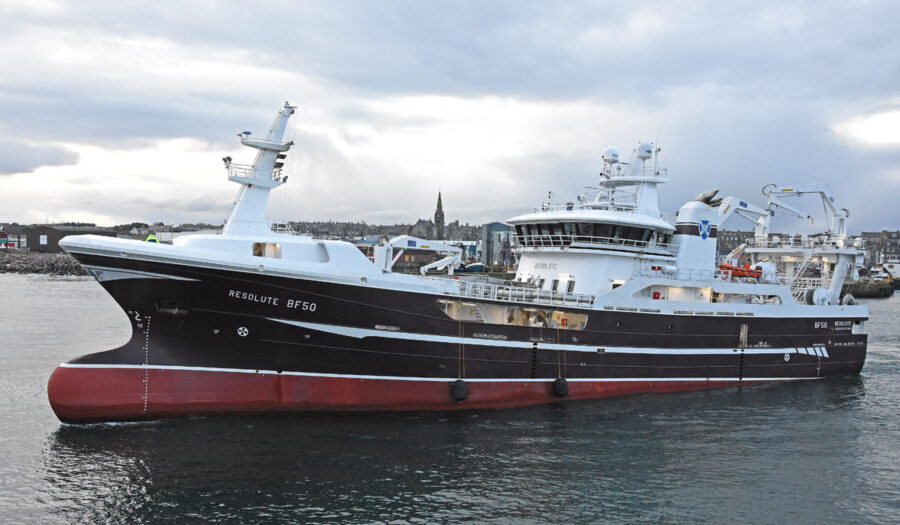Gardenstown midwater trawler makes her mark fishing mackerel
Skippers Matthew and Alexander West and the crew of Resolute BF 50 have quickly started to showcase the fishing capabilities of their new vessel, reports David Linkie
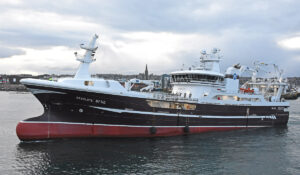
01 Resolute leaving Fraserburgh for the first mackerel trip of this year.
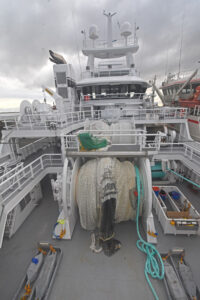
02 General view of arrangements on the trawl deck from atop the gantry.
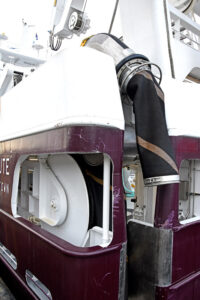
03 Stern pumping arrangements at the port quarter
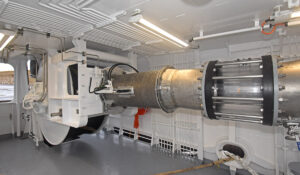
04 and the fish hose reel and pipe configuration on the shelterdeck.
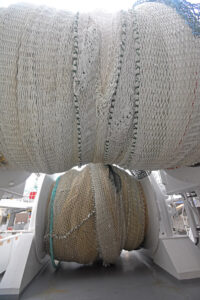
05 Midwater trawls and braillers from Jackson Trawls and Swan Net-Gundry on the 110t net drums arranged in waterfall style at the head of the trawl deck.

06 The West family stem crest.

07 Wärtsilä logos are displayed either side of the accommodation casing.
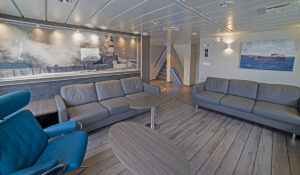
08 The comfortable day lounge is separated from the messdeck by an impressive engraved glass panel of Fraserburgh north breakwater in poor weather.

09 Aerial view of Resolute during sea trials in the Bay of Biscay.
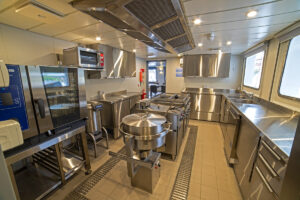
10 Resolute’s well-equipped stainless steel galley
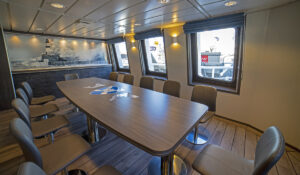
11 and messdeck.
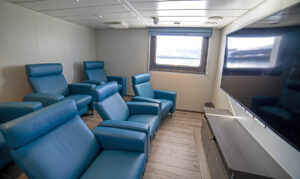
12 The cinema room.
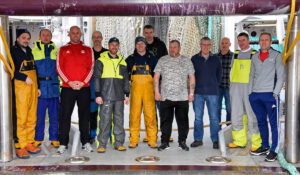
13 Resolute’s crew ready to start fishing mackerel in January.Left to right: Mark Stephen, John George West, Matty West, Martin Smart, Kenny West, Colin Gibson, Andrew West, David Lyon, James West, Alistair Gibson, Zaz Buchan and Ally West.
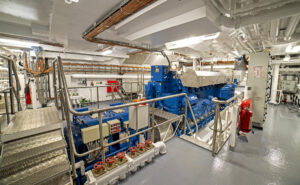
14 Overall view of the engineroom.

15 The main electrical distribution cabinets.
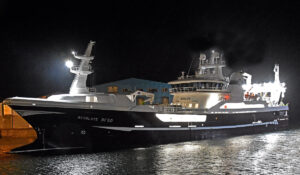
16 Resolute returning to Fraserburgh in December after performing well on her first mackerel trips.
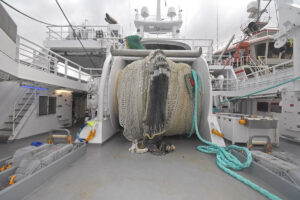
17 Looking forward
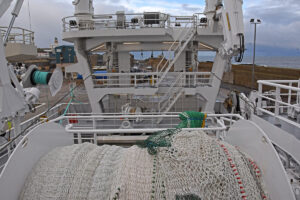
18 and aft along the trawl deck.
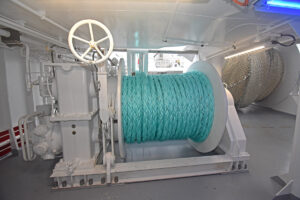
19 The 71t lifeline winch is mounted on the starboard side of the shelterdeck.
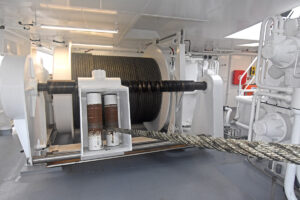
20 The port side split trawl winch.

21 The Karm fish pump and hydraulic hose reel are arranged on the port side of the fo’c’sle deck

22 aft of the tail-end winch on the upper boat deck.

23 Port quarter view of Resolute turning towards the north on leaving Fraserburgh harbour.
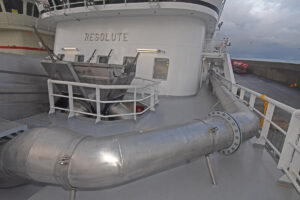
24 The stainless steel delivery pipe leads forward along the fo’c’sle deck

25 to the double-ended C-Flow dewatering system
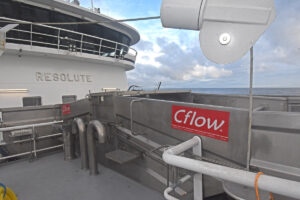
26 which is located amidships.
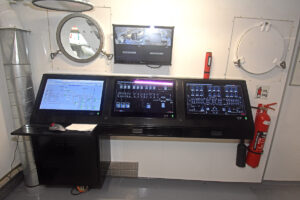
27 The flow of pelagic fish to the RSW tanks is controlled from the deckhouse.

28 The aft arrangement of delivery pipes leading directly to the RSW tanks.
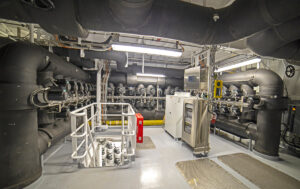
29 The RSW valve actuator room.

30 Resolute lying in Fraserburgh harbour.
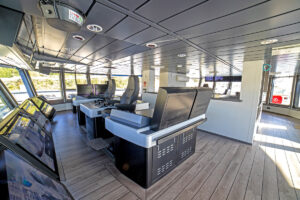
31 Two views of the main console
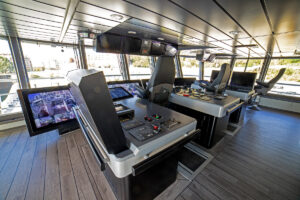
32 centrally arranged across the front of Resolute’s wheelhouse.
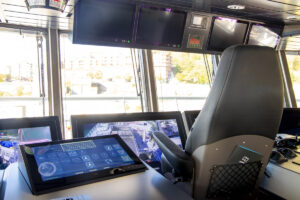
33 The trawling station.
On arrival at Fraserburgh from Spain in mid-November, the 69.8m LOA Resolute took her midwater trawl gear aboard in just 24 hours and crossed the North Sea to run fishing trials from Norway, before immediately starting to fish mackerel some 50 miles east of Shetland.
Although the Scottish pelagic fleet had already been tied up for nearly a month having caught its annual allocation, a good spread of marks enabled Resolute to hit the ground running and make four successful back-to-back trips under calendar pressure.
Four days into the new year, Resolute sailed from Fraserburgh to start fishing mackerel in deeper water to the west of Shetland in the vicinity of Sule Skerry, as the fish followed their well-established migratory route into the southwest. Resolute was again reported to have performed well while encountering some typically heavy January weather in the North Atlantic, including 50-knot northwesterly winds two weeks ago.
That Resolute was able to take her 2021 mackerel quota despite having been built in Spain amidst a global pandemic – which led to major issues and inevitably pushed the completion date back considerably – is testament to the effort everyone involved in the international build programme put in to achieve a successful outcome.
This is especially true of the skippers and crew, who were more than 1,000 miles from home for a long period of time, but showed the determination needed to ensure that Resolute now has a run of landings to her name.
Resolute was designed by the Wärtsilä Technology Group and built at the Astilleros Balenciaga shipyard at Zumaia, Spain, for Castlehill LLP.
Resolute replaces the owners’ previous 17-year-old vessel of the same name, which was bought by the Wiseman Fishing Company and renamed Artemis BF 60 a year ago.
Maximal levels of crew safety and comfort, catch quality and working efficiency were identified as the main priorities at the start of the three-year design and build project to replace their well-proven previous vessel.
While very much a new generation of vessel incorporating the latest technology, Resolute is designed to replicate the fishing capabilities of the owners’ previous vessel, and to fish the same annual allocations of herring and mackerel.
That Resolute features a similar Wärtsilä 9L32 main engine to her predecessor and Karmøy deck machinery illustrate the owners’ confidence in well-proven machinery. Modern ideas include pumping fish over the stern – a first for the skippers and crew – and a full-length boat deck.
Alongside her new design, Resolute also features a new generation of wheelhouse team, with cousins Matthew and Alexander now fully taking over from their fathers David and George West at the end of a gradual and well-managed transition period.
Shortly before sailing from Fraserburgh earlier this month, skippers Matthew and Alexander West said: “The time was right to upgrade to a new vessel, which will enable us to follow our well-established seasonal fishing patterns with enhanced efficiency and safety. The biggest single difference is pumping fish at the stern – a change we are steadily getting accustomed to, and one that is already bringing benefits.
“While the Covid-19 virus clearly created major issues and time delays, we got there in time to fish mackerel at the end of last year. Initial indications are that Resolute is a fine sea boat, and one that will stand us in good stead in years to come.”
Insured by Sunderland Marine, working through Westward Fishing Company Ltd, Fraserburgh and sailing with a crew of 12, Resolute will fish mackerel in the North Sea towards the end of the year and in the North Atlantic in January/February, together with North Sea herring in August.
Working in close liaison with the owners, the Wärtsilä Technology Group provided a complete vessel design package, as well as supplying the centreline propulsion package, which gave Resolute an average top speed of 16 knots on engine trials in the Bay of Biscay.
While Resolute is the first midwater trawler of this design to be built by Astilleros Balenciaga SA, the yard has built a series of pelagic vessels, including the Dutch-owned pair-trawlers Wiron 1 and 2, and the Spanish-style purse-seiners Playa Del Ris and Feline Ruano, as well as a long list of Grampian-class supply boats, during its 97-year history.
General arrangement
With a length between perpendiculars of 61.8m, 14.60m of beam, a depth to main deck of 9m and a scantling draught of 7.2m, Resolute’s round bilge hull was built to Det Norske Veritas +1A Fishing Vessel classification.
Resolute effectively features three continuous decks – main, shelter and fo’c’sle, on which a 70t anti-roll tank is located forward, together with a low-profile compartment in which the anchor windlasses and mooring winches are housed. The aft section of this compartment is connected to the hull sides by short gull-wing-type sections to give a streamlined appearance. Continuous wide side decks run the full length of the vessel.
With a capacity of 2,040m3, Resolute’s nine RSW tanks are arranged from forward in three tiers of three. Side passages extend along the sides of the RSW tanks at main deck level. The vacuum landing tanks and machinery are housed between the forward and middle tiers of RSW tanks.
Below the main (third) deck, the hull is subdivided into forepeak housing RSW feeder tanks, sonar/bow thruster, RSW pump room, three tiers of RSW tanks, engineroom/auxiliary engineroom (port), and aft peak with lube/hydraulic oil and fuel tanks, including a settling and two daily service tanks.
At main (second) deck level, the arrangements from forward are forepeak, refrigeration plant room and vacuum pump room, forward tier of RSW tanks, vacuum discharge equipment, middle/aft tiers of RSW tanks, engine control/switchboard room, engine workshop stores and change room (port), four twin-berth cabins and laundry (starboard), hydraulic pump room/steering gear compartment (centre/port), and a large net store including two bins to starboard.
Layout on the shelter (first) deck consists of forepeak store, harbour genset and auxiliary engine rooms, tank tops with delivery pipes for RSW tanks, deck house for fish sampling, and pumping and vacuum landing control screens. Seven single ensuite cabins, together with the hospital cabin, are arranged across the front and down the starboard side of the casing, along the starboard side of the hull. The main deck change and drying rooms are centrally positioned to starboard of the exhaust casing.
At fo’c’sle deck level, the day lounge is located on the port side of an adjoining expansive messdeck, which is served by a single elliptical table. A dramatic double-sided engraved glass panel depicting heavy seas crashing against Fraserburgh’s north breakwater and the Golden Horn lighthouse separates the messdeck from the day lounge. A smaller cinema room is located aft of the day lounge.
Cook Andrew West’s well-equipped stainless steel galley lies to port, forward of a large chilled dry provisions room that also gives access to adjacent walk-in refrigerated and freezer stores.
Featuring modern light laminates and stainless steel hand-rails that enhance the spacious feel throughout the boat, all the accommodation areas onboard Resolute are finished to high levels of specification and workmanship. All internal finishings were carried out by Norwegian specialist Maritime Montering AS.
Engineroom
Resolute’s main engine is a Wärtsilä 9L32 delivering 5,200kW @ 750rpm. The propulsion unit is coupled to a Wärtsilä SCV 90/2-PDC58 5.091:1 reduction gearbox to turn a Wärtsilä 4,000mm-diameter four-bladed CP propeller in a Wärtsilä high-performance fixed nozzle. This combination of centreline machinery gives Resolute an average top speed of 16 knots.
A PTO on the gearbox drives a Marelli shaft generator producing 2,500kWe @ 1,200rpm.
Auxiliary electrical power on Resolute is provided by a bank of three Mitsubishi gensets delivering a total of 2,400kWe, two of which are housed in a soundproofed room on the port side of the engineroom. A Mitsubishi 6D24-TC harbour generator developing 200kWe is located forward, together with one of the 600kWe generators.
When Resolute is hauling and shooting the fishing gear, the gearbox PTO will be clutched in, enabling electrical power for the electro-hydraulic motors to be supplied from the shaft alternator. This arrangement reflects the fact that when full power is required for the deck machinery, there will normally not be same demand for power on the main engine, allowing it to meet requirements for both the propulsion and electro-hydraulic systems.
During normal towing, the shaft alternator can be disengaged from the switchboard, when electrical power is supplied by the gensets through the main switchboard and controlled by the vessel’s power management system.
Two Brunvoll electrically driven tunnel thrusters of 900kW, in which skewed bladed propellers combine optimal thrust with low noise, assist vessel handling in confined areas and when keeping station to fishing gear.
A combination of double bottom and deep fuel tanks allow 420,000 litres of fuel to be carried, while the vessel’s freshwater capacity is 60,000 litres. A 70m3 passive roll-reduction tank is positioned forward on the boat deck.
Resolute’s engineers Martin Smart, James West, David Lyon and Mark Stephen monitor the performance of all the vessel’s propulsion and generating machinery, the catch storage and the comprehensive alarm systems from a separate soundproofed control room and office, sharing 24-hour watch duties. Situated on the port side of the main deck, the control room also houses the main electrical switchboards and the computer monitors for Resolute’s Smart Solutions vessel management system.
Midwater trawling arrangements
Norwegian specialist Karmøy Winch AS, Kopervik, supplied a comprehensive package of bespoke hydraulic deck machinery to Resolute.
The midwater trawling units are located on three levels – shelter, boat and upper boat decks – in a customised arrangement in line with the owners’ requirements.
Two 91t core pull split trawl winches are positioned close to the hull sides directly abaft the accommodation casing on the forecastle deck. This location was chosen to give the under-spooled trawl wire the minimum angle of elevation to the inboard hanging blocks mounted on the underside of the trawl gantry.
Integrated into the stern construction of Resolute, the two-level trawl gantry also accommodates lifeline and tail-end blocks, together with two knuckle-boom deck cranes and the net-sounder winch.
Spooled with 2,000m lengths of 38mm-diameter Bridon Starfish wire supplied by Jackson Trawls and protected by the boat deck sidewalks, the split trawl winches, together with the net-sounder winch atop the gantry, function through Resolute’s Karm computer autotrawl system.
Midwater trawls are worked from two 110t net drums positioned centrally at shelter and forecastle deck level in waterfall style above a single set of toe-end weight tracks. A large-diameter roller, positioned above the lower drum, comes into play when shooting and hauling the trawl off the slightly higher forward net drum at the head of the trawl deck.
Two outhaul winches are mounted aft on the wrap-round forecastle deck under the stern gantry, for use when shooting away the bag and other duties on the trawl deck. When fishing in poor, heavy weather, the central opening through which midwater trawls are worked can be sealed off by raising a hydraulically operated gate, positioned aft of the four customary guiding-on pins.
A 71t lifeline winch for handling the bag is located on the starboard side of the shelterdeck.
A 57t tail-end winch, used for pulling the bag to the stern before the sock is taken up and attached to the aft fish pump, is positioned to port on the upper boat deck, in line with a dedicated sheave mounted within the mid-height trawl gantry.
Three remote-controlled Karm deck cranes are also fitted. Two are positioned atop the trawl gantry; one is a net-stacker crane for general gear-handling duties, while the second crane is dedicated to the handling of the fish pump. A 4t/14.5m knuckle-boom crane covers the foredeck.
Resolute’s deck machinery is powered by an arsenal of electro-hydraulic power packs situated in the full-width pump room on the main deck aft.
Fish pumping
At the end of a successful tow, catches of herring and mackerel are taken aboard aft on the port side of Resolute, before the fish are pumped forward to the Cflow double dewatering system set into the forecastle deck amidships.
When the 24in Karm fish pump is lowered into the water by the dedicated overhead Karmøy crane and the bag slackened off, 80m of 20in fish hose is spooled off a pump-through reel mounted on the shelterdeck directly below the fish pump.
The fish hose permanently connected to the pump sits in a deep captive vertical slot in the port side of the transom, allowing the hose to run clear of the stern as the pump is lowered into the water by the dedicated overhead crane.
The customary large-diameter stainless steel delivery pipe is mounted on the forecastle deck and then routed inboard towards the bottom of the fish/seawater separator system.
A short clear perspex section incorporated into the first section of the main pipe allows the flow of fish to be constantly monitored, either from the deck or by CCTV coverage in the wheelhouse, where the skippers can take full control of fish pumping operations from a dedicated console directly in line with the port quarter.
When pumping, the flow of pelagic fish from the separator into the nine RSW tanks is remotely controlled from a dedicated room in the deck house.
On entering the water separator, fish are directed upwards before sliding either forward or aft into transverse troughs, from where they are directed to either side through stainless steel pipes to enclosed receiving boxes. Three pipes controlled by vertically operated knife gates deliver fish to the selected aft RSW tanks directly through the shelterdeck, thereby keeping the tank tops clear for easy visual inspection.
Two delivery pipes lead fish to the first two tiers of tanks from the forward receiving boxes.
Constant sample weighing of fish is carried out when Resolute is pumping using Marel M2200 electronic scales and pelagic sampling software.
With buyers worldwide, particularly in Japan, requiring ever-higher standards of catch quality, the owners placed particular emphasis on Resolute landing a top-quality product by being able to reduce the temperature of pelagic fish entering the RSW tanks to an optimum storage temperature of between 0ºC and 1ºC as quickly as possible.
Two FrioNordica ammonia-based refrigeration plants produce 2,300kW of cooling capacity, enabling pelagic catches to be brought down to the desired level in often less than two hours, depending on the quantity of fish pumped aboard and the number of RSW tanks brought into use. This process is enhanced by the availability of 229t of seawater carried in RSW feeder tanks. Resolute’s RSW system is served by two 800m3/hr circulation pumps and two 300m3/hr condenser pumps.
Fish quality is further enhanced by circulating purified seawater, supplied from a Normex ozone plant, through the nine RSW tanks when the vessel is steaming, before the next shot of pelagic fish is pumped aboard.
The distribution of pelagic fish into the RSW tanks through tank sounding, and pump and valve control when pumping, is handled by a Cflow computer control and monitoring system.
Pelagic catches from Resolute are discharged to processing factories ashore by twin Samson 3,500-litre vacuum pumping systems. Operated by four 80kW compressor units, the system has a discharging capacity of up to 2 x 250t per hour.
High-tech electronic equipment from three local companies
Three specialist companies in North East Scotland, Furuno UK, Scanmar UK and Woodsons, supplied the customary array of navigation, fish-finding and net-monitoring equipment that skippers Matty and Ally West are now using to good effect in Resolute’s wheelhouse.
Information from the state of the art electronic equipment, which is installed in a separate instrument room directly below the wheelhouse, is displayed through a Furuno big bridge system encompassing four 55in 4K Hatteland floor-mounted tilting screens and 16 26in Hatteland fixed screens in different configurations depending on the vessel’s mode of operation. The system is driven by an advanced video wall controller that takes in all the images from the equipment, integrated into a touch-screen command and control system. The skippers can select steaming, searching, fishing and harbour modes, and the bridge will automatically reconfigure to the required layout.
When searching for fish, the 55in displays can be put to their full advantage, displaying full-screen high-resolution (4K) sonar images. This layout can be changed with one touch to show split-screen CCTV with radar chart overlay and conning information, for steaming or entering harbour.
Three 24in touch-screen command centres are located on the port and starboard consoles, and aft at the winch controls. From here, the skippers can use a single trackball or touch screen to control all the navigation and fishing equipment on the vessel. The touch screen has soft-touch controllers that copy the radar, ECDIS and sonar keyboards, allowing them to be mounted out of sight to keep the bridge clean and uncluttered.
The Furuno big bridge system is located in front of two NorSap 1600S skipper’s chairs, positioned between wing and island consoles, which together form the main navigation position.
Freestanding wing consoles, for use when Resolute is being manoeuvred in confined areas, are located at the forward corners of the wheelhouse. The overhead screen display above the wing consoles can also be configured to the skipper’s individual preferences.
The central fishing console aft provides a commanding view of midwater trawling activities across the stern, while radar, sonar, trawl monitoring and chart information can be viewed and controlled on the upper four 26in Hatteland displays.
For long-range fish detection, Resolute is equipped with the latest-model low-frequency omni-sonar from Furuno. The FSV-25 has a narrow vertical beam, allowing echo detection at very long range, and also using a unique dual-range function where one sonar can effectively become two with independent control of range, tilt and gain on each screen.
For medium- and close-range echo detection, skippers Matty and Ally West use Furuno FSV-85 medium-frequency 94kHz and Furuno FSV-75 high-frequency (164kHz) omni sonars, providing excellent clarity on smaller marks coming off the bottom.
Vertical echo detection is performed by Simrad ES80 split-beam, Furuno FSS-1BB fish-species discrimination and Furuno FCV-2100 fish-sizing sounders. Sweeping through a broad range of frequencies, the latter two units calculate the breakdown of species types in any given shoal, and provide graphical information to the skipper to help ensure that only the target species actually ends up in the net.
Resolute is also equipped with a WASSP F3XLi multi-beam sounder.
The performance of Resolute’s midwater trawls when towing is monitored by a Simrad ES70 trawl sonar operating through the cable winch atop the gantry.
The high specification of electronic equipment fitted is further highlighted by the presence of a Furuno FMD-3200 BB electronic chart display and information system (ECDIS), supplied by Furuno UK of Fraserburgh. Providing fast, intuitive course planning and navigation monitoring, the ECDIS unit – for which Thomas Gunn of Poseidon Navigation Services, Buckie, will provide updated electronic charts every month – is supported by two type-approved Furuno chart radars – FAR 3238S-NXT S-Band and FAR 2228-BB X-band. A third Furuno radar is interfaced to the TimeZero plotters.
Navigation equipment includes two TimeZero Professional plotters integrated to radars, sounders, WASSP, GPS and AIS, and an Olex 3D seabed mapping plotter.
GPS and heading data is provided by two Furuno GP170 type-approved GPS receivers, Furuno SC-70 satellite compasses, a Simrad GC80 expanded gyro system, and a Simrad AP70 Mk II autopilot system.
AIS information is handled by the latest-model Furuno FA-170.
A Furuno CI-68 BB current indicator provides tidal data at five different depths, passing this information to the long-range sonars.
A Furuno BR-500 watch alarm system gives peace of mind to the skipper and crew when Resolute is steaming to and from the fishing grounds.
The vessel’s extensive communications system includes a full Sailor GMDSS package. Jotron EPIRBs and SARTs are also fitted.
Scanmar ScanScreen catch-control and gear-monitoring systems
Resolute is the latest in a succession of new midwater trawlers to be equipped with a Scanbas 365 catch-/net-monitoring system supplied and installed by Scanmar UK Ltd of Peterhead.
A combination of wide digital receivers (WDRs) and the latest 365 software allows the wide range of door and net sensors to be configured from the multi-display units in the wheelhouse.
Resolute has all catch-control information displayed across two screens. The first screen relays information from the front of the trawl, and the second screen provides information based on the target species as it travels down the bag into the codend.
A wide-beam Trawl Eye positioned in the tunnel section provides continually updated information on the location and movement of fish towards the brailler, on which four SS4 super-catch sensors are fitted.
Resolute has an SS4 depth sensor with ‘filling indicator’ mounted on the aft side of the splitter to monitor the bag when hauling.
Scanmar SS4 distance sensors, complete with distance, angle, pitch and roll functions, are mounted on the Vónin trawl doors.
Sensor signal reception while trawling is collected from four H4B30X50 single-beam hydrophones, mounted on both port and starboard blister housings.
Four QBC-X1 charging units are mounted in a readily accessible store forward of the trawl deck.
Leading net-makers supply midwater gear
Resolute’s midwater gear came from two well-known net-making companies, Jackson Trawls, Peterhead and Swan Net-Gundry, Killybegs.
The 1,100m dual-purpose mackerel/herring midwater trawl made by Jacksons is similar in design to one that performed consistently well on the previous Resolute, with braided nylon in the mouth, 12.8m mesh in the top and side panels, 6.4m mesh in the lower panel and an eight-panel tunnel, and rigged on Dyneema frame ropes with colour-coded lacings.
Jackson Trawls also supplied two 70m braillers to Resolute. Incorporating eight-panels along their full length, the heavily constructed bags are made to a new and slightly wider design, giving greater internal volume geared to pumping pelagic fish at the stern.
Well-proven customer satisfaction also resulted in Swan Net-Gundry supplying a similar package of midwater trawl gear to Resolute, including a Swan 1,280m Helix SS Guider Trawl for mackerel (this is the newest version of the Swan 1,280m Helix SS Trawl that performed extremely well on the previous Resolute). Swan Net-Gundry also supplied its well-known Swan 65m Fast Flow 8P Codend with DHS (DynIce Handle System).
Jackson Trawls also supplied two 2,000m lengths of 38mm-diameter Bridon Dyform Starfish trawl wire to Resolute.
The vessel was also supplied with a full package of 36mm x 130m polyester-covered Dyneema sweeps, along with DynIce splitters and brailler ropes.
Jackson Trawls supplied the life line and full chandlery package for rigging out Resolute.
Resolute is the latest in a succession of new midwater vessels to use a set of Vónin Tornado 10m2 doors to spread the midwater trawls.
Second Resolute continues Gardenstown family traditions
The new Resolute replaces the owners’ previous 64m midwater trawler of the same name, built by West Contactors at Ølensvåg, Norway in 2003 for Gardenstown skippers David and George West. They have now retired and passed over skippers’ responsibilities to their sons Matthew and Alexander, who have been on the family boat since leaving school.
The former Resolute continues to operate from Fraserburgh after being renamed Artemis BF 60 by the Wiseman Fishing Company.
Brothers David and George West took delivery of the first Resolute in 2003 after combining the quotas and licences from their previous 23-year-old boats Prowess BF 720 and Courage BF 212 – which they had used for both purse-netting and pair-trawling, depending on conditions and seasons – in order to modernise their operation. This was necessary in order to compete effectively with the succession of newer boats being built around this time, which were capable of delivering larger quantities of optimal-quality fish in the minimum time to secure premium prices.
David West’s previous command, the 51.5m Prowess, was bought by the Northbay Fishing Company and re-registered CY 720. Built at Kootstertille in 1980 as Paula SO 720 for the Doyle Fishing Company of Killybegs, Prowess came to Fraserburgh in 1994. This vessel replaced the previous 47m Prowess BF 50, built in Norway in 1960, which skipper David West purchased in 1985 from a Canadian company and subsequently extensively modernised and lengthened.
The 61.3m Courage was built in 1980 as Azalea LK 396 for Whalsay skipper Josie Simpson as a purser/trawler. Seven years later, this boat was extensively lengthened amidships and aft, before being bought by another Whalsay skipper, Willie Williamson, and then sold in 1996 to George West and renamed Courage.
This replaced a previous purse-seiner of the same name, which Hall and Russell built at Aberdeen in 1974 for the West family. Skippered by George West Snr with David West as mate, this 88ft steel-hulled purser replaced the original 73ft 6in wooden-hulled Prowess BF 50.
This trawler/purser was built in 1967 at Macduff by John Watt and Sons. Powered by a 320hp Kelvin engine and skippered by George West Snr, Prowess BF 460 went purse-netting with William West’s smaller boat Havilah BF 161, which acted as partner boat in the early days of purse-netting to keep Prowess off her net.

